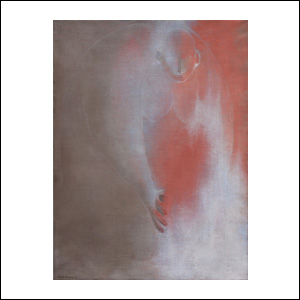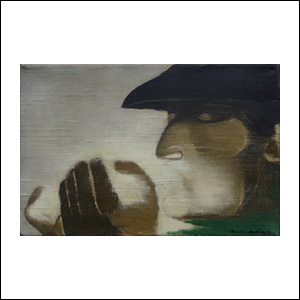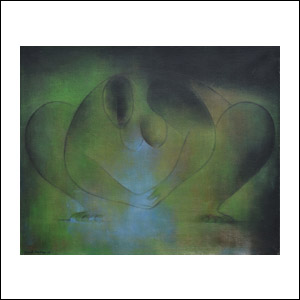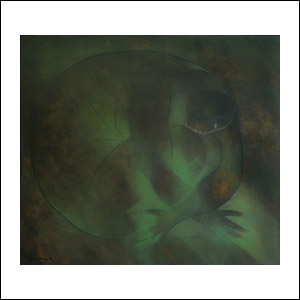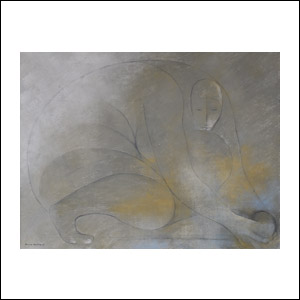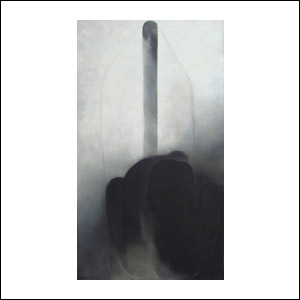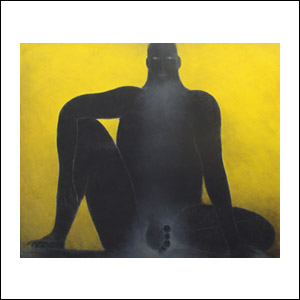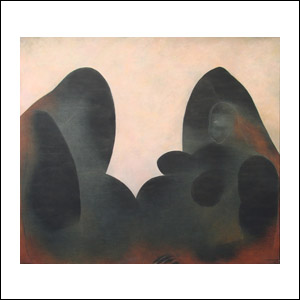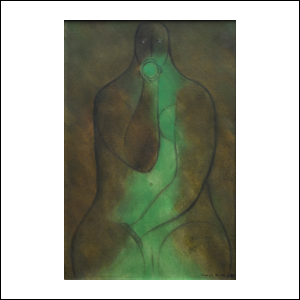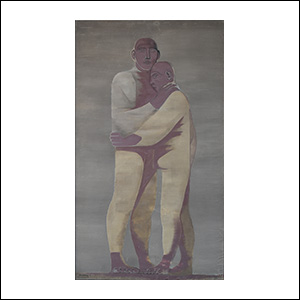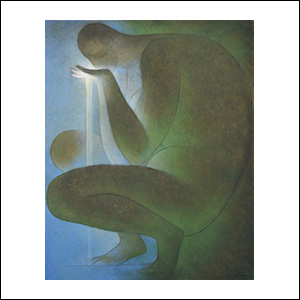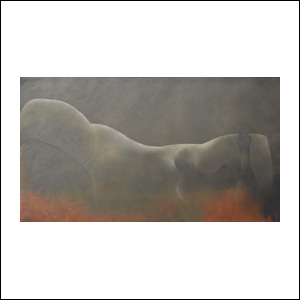Ricardo Martinez de Hoyos
Mexico City, 1918 - Mexico City, 2009
RICARDO MARTINEZ DE HOYOS - BIOGRAPHY
Ricardo Martinez de Hoyos was born on October 28, 1918 in Mexico City. He was a painter who developed in a period of profound transformation in Mexican painting. He began to paint in the last years of the Mexican School of Painting, he was a precursor of the Rupture Movement and later developed parallel to it, since he never felt part of said movement or any other. Ricardo Martinez inherited the interest in the culture and aesthetics of the pre-Hispanic civilizations that the generation before him, the Mexican School of Painting, had cultivated in their works, and mixed it in his painting with the avant-garde trends that occurred in the second half of the 20th century.
Ricardo Martinez was the thirteenth of sixteen siblings. His brother, Oliverio Martinez who was a sculptor, was the one who promoted him in his beginnings as an artist. Ricardo lived from 1928 to 1932 in San Antonio, Texas, with his mother and some of his siblings. He greatly enjoyed the American school and learned English. Since then he liked to draw. In a letter, his brother Oliverio, who was around 17 years older than him, tells him: “study and continue drawing, on your return, I will take care of you." Upon returning to Mexico Ricardo continued his studies, however he liked drawing more than studying.
In the years of 1934 and 1935, Ricardo Martinez collaborated with his brother Oliverio in the construction and installation of the Monument to the Revolution in Mexico City, where he met the sculptor Francisco Zuñiga with whom he had a close friendship. In 1938, he entered the National Preparatory School. Within a year of admission, he released a manifesto urging students and authorities to protect the school's murals from vandalism by the students themselves. That year he made his first tempera painting.
Ricardo Martínez began his law degree at the Universidad Autónoma de Mexico in 1940, which he left a few months later to dedicate himself to painting. With that conviction he enrolled in the Escuela Nacional de Artes Plásticas (former Academy of San Carlos), however he stopped attending shortly and began to learn to paint self-taught using books such as The Materials of the Artist by Max Doerner.
His early works show the influence of Julio Castellanos, then there was an influence of Federico Cantu regarding his themes, with whom he became friends in 1943. Later, there is an influence from Manuel Rodriguez Lozano, Jose Clemente Orozco and Giorgio de Chirico. It was not until 1953 that his style took a definitive course. Ricardo Martinez was attracted like many other artists of his time to pre-Hispanic art, which led him to gradually form an important collection and incorporate its aesthetics into his painting. His production from 1953 to 1957 forms a second creative stage, in which he introduced shapes and features of the pre-Hispanic sculptures and masks, thus configuring his own visual language that gradually led him to the development of the style that will characterize him during the rest of his lifetime. During this stage, he represented characters in traditional scenes, performing their daily tasks or exhibiting traditional elements of culture, such as music or food.
In his paintings from 1957 onwards, a new figuration and his characteristic treatment of the human figure can be seen. Corpulent and volumetric figures are the protagonists of his paintings. The pre-Hispanic world continues to be a source of inspiration, but expressed in more refined lines. The blur will be a fundamental element, both in the contours of the figures and in the applications of light and color. The light management is masterful and the volumes of the figures are achieved through color. The atmosphere of his works is very particular and serves to generate light in the compositions. The themes represented are daily, erotic or emotional, with a great emotional charge. The monumentality of the figures that cover almost the entire work compete only with the feeling of spirituality that they transmit.
In 1943, Ricardo Martinez met Ines Amor, director of Galeria de Arte Mexicano. She began to represent him and presented his first solo exhibition in her gallery in 1944. His works began to be exhibited both individually and collectively in galleries, museums and art centers in Mexico and the United States. He taught painting at the Fine Arts Center School in Colorado Springs, and later in San Diego, California. He became friends with the French muralist Jean Charlot, director of the Fine Arts Center School, where Ricardo Martinez presented his first solo exhibition abroad in 1948. His first solo exhibitions in a museum were at the Phoenix Art Museum in 1966 and at the Museum of Modern Art in Mexico City in 1969.
He illustrated several books, such as: Recuento de Poemas (1950-1993) by Jaime Sabines, La Cabeza de la Hiedra by Carlos Fuentes, Recolección de mediodia by Ernesto Mejia Sanchez, El Espiritu de Don Juan Una Introduccion a la Obra de Carlos Castaneda by Joaquin Castillo and Richard Dixey, Retrato Critico by Ali Chumacero, El Humanismo en el Nuevo Mundo by Raul Horta, La Herencia by Jorge G. Castañeda, among others.
He received several awards and recognitions throughout his life, such as: the Moinho Santista Acquisition Prize, highest award from the Sao Paulo Biennial, Brazil (1964); Raul Bailleres Award, Mexico (1967); he rejected the National Prize for the Arts for not wanting to share it with Juan O’Gorman (1972); he was named Artist Emeritus by Fondo Nacional para la Cultura y las Artes, Mexico (1993); Gold Medal by Instituto Nacional de Bellas Artes, Mexico (2008); and Federal District Medal by the Government of Mexico City (2008). Throughout his life and to date several books on his painting have been published.
Ricardo Martinez died on January 11, 2009 in Mexico City.
(Sources:1. Ricardo Martínez, A 100 años de su nacimiento, Fundación Ricardo Martínez, 2018; 2. Ricardo Martínez, Editorial RM, 2012; 3. Ricardo Martínez, Exposición Antológica, Palacio de Bellas Artes, 1994, texto de Rubén Bonifaz Nuño)
Ricardo Martinez Main Solo Exhibitions
|
1944 Galería de Arte Mexicano, Mexico City |
|
1947 Diez óleos recientes, Galería de Arte Mexicano, Mexico City |
|
1948 Fine Arts Center, Colorado Spring, United States |
|
1950 Galería de Arte Mexicano, Mexico City |
|
1951 Oleos y sanguínas, Galería de Arte Mexicano, Mexico City |
|
1952 Trece óleos recientes, Galería de Arte Mexicano, Mexico City |
|
1954 Oleos de Ricardo Martínez, Galería de Arte Mexicano, Mexico City |
|
1955 Galería de Arte Mexicano, Mexico City |
|
1956 Quince óleos, Galería de Arte Mexicano, Mexico City |
|
1958 Oleos, Galería de Arte Mexicano, Mexico City |
|
1959 Ricardo Martínez, The Contemporaries Gallery, New York |
|
1960 The Contemporaries Gallery, New York |
|
1961 Exhibition of Recent Paintings, The Contemporaries Gallery, New York |
|
1963 Bienal de Sao Paulo, Brazil |
|
1964 Galería de Arte Mexicano, Mexico City |
|
1964 The Contemporaries Gallery, New York |
|
1966 Ricardo Martinez. Recent Paintings, Phoenix Art Museum, Phoenix |
|
1969 Pintura de Ricardo Martínez, Museo de Arte Moderno, Mexico City |
|
1974 Ricardo Martínez. 40 pinturas. Expansión Rítmica de los Volúmenes, Museo de Arte Moderno, Mexico City |
|
1976 The Sindin Gallery, New York |
|
1984 Ricardo Martínez, Obra Reciente, 1975-1984, Museo del Palacio de Bellas Artes, Mexico City |
|
1994 Ricardo Martínez, Exposición Antológica, Homenaje Nacional, Museo del Palacio de Bellas Artes, Mexico City |
|
2001 Club de Banqueros, Mexico City |
|
2011 Ricardo Martínez, Museo de la Ciudad de México, Mexico City |
|
2018 Ricardo Martínez y la Figura Humana, Casa de Cultura Citibanamex, Museo Casa Montejo, Mexico City |
|
2018 Ricardo Martínez desde el Interior, Museo de Bellas Artes, Mexico City |
|
2019 Ricardo Martínez desde el Interior, Museo de Aguascalientes |
|
2019 Ricardo Martínez y la Figura Humana, Casa de Cultura Citibanamex - Casa del Mayorazgo de la Canal, San Miguel de Allende, Guanajuato |

